2022中考英语一轮复习PPT课件 第1课时 Units 1—6,Book 7A
文档属性
| 名称 | 2022中考英语一轮复习PPT课件 第1课时 Units 1—6,Book 7A | 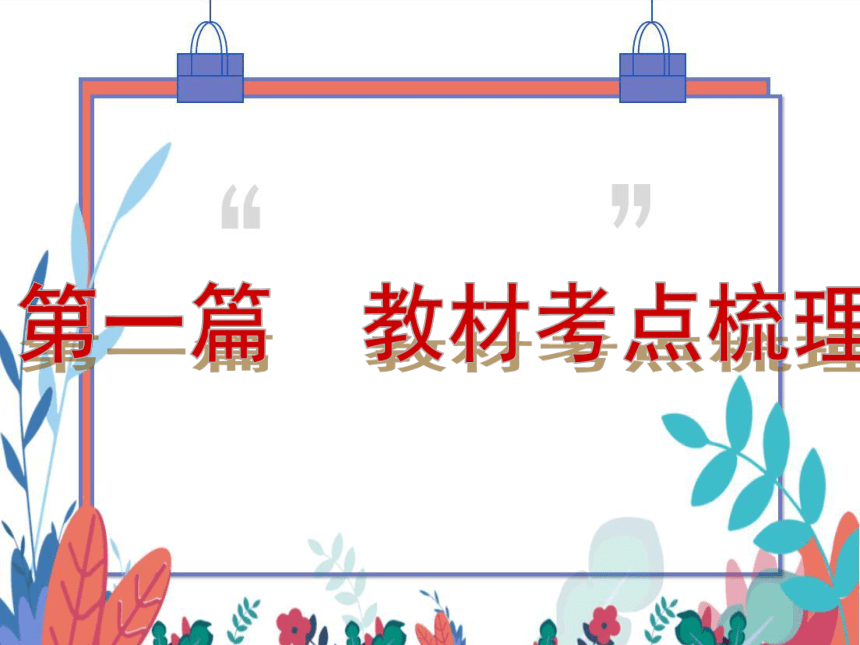 | |
| 格式 | ppt | ||
| 文件大小 | 1.1MB | ||
| 资源类型 | 试卷 | ||
| 版本资源 | 通用版 | ||
| 科目 | 英语 | ||
| 更新时间 | 2022-06-01 15:06:18 | ||
图片预览

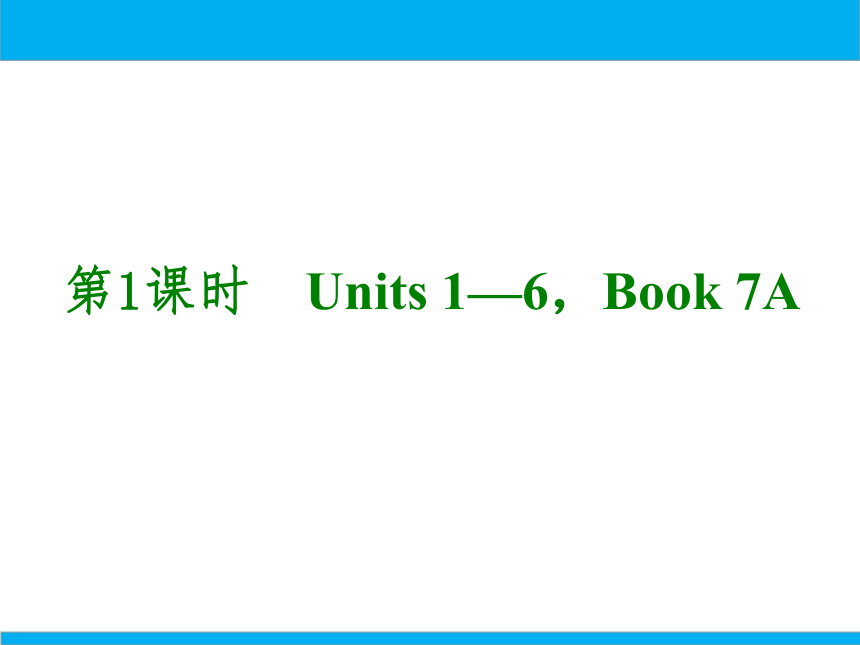
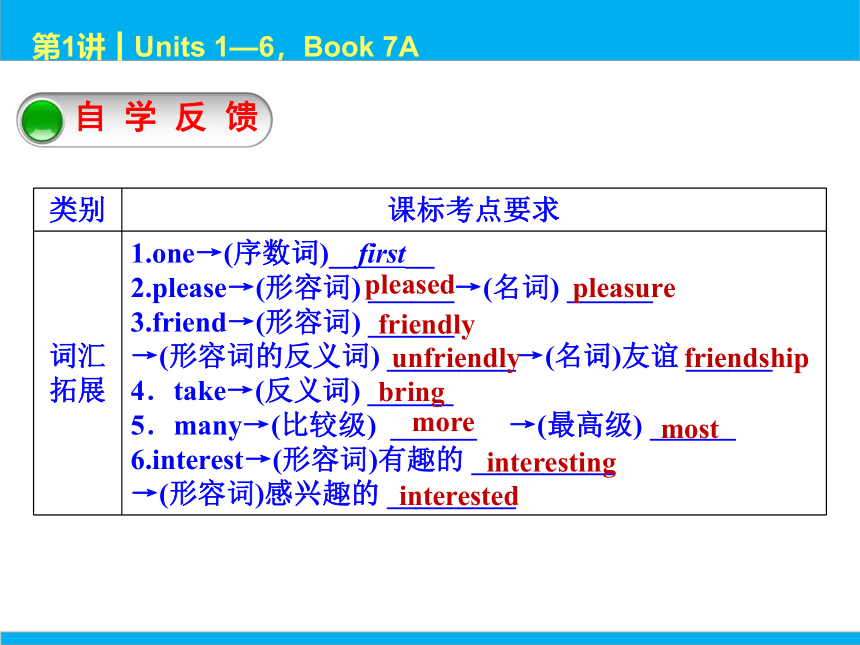
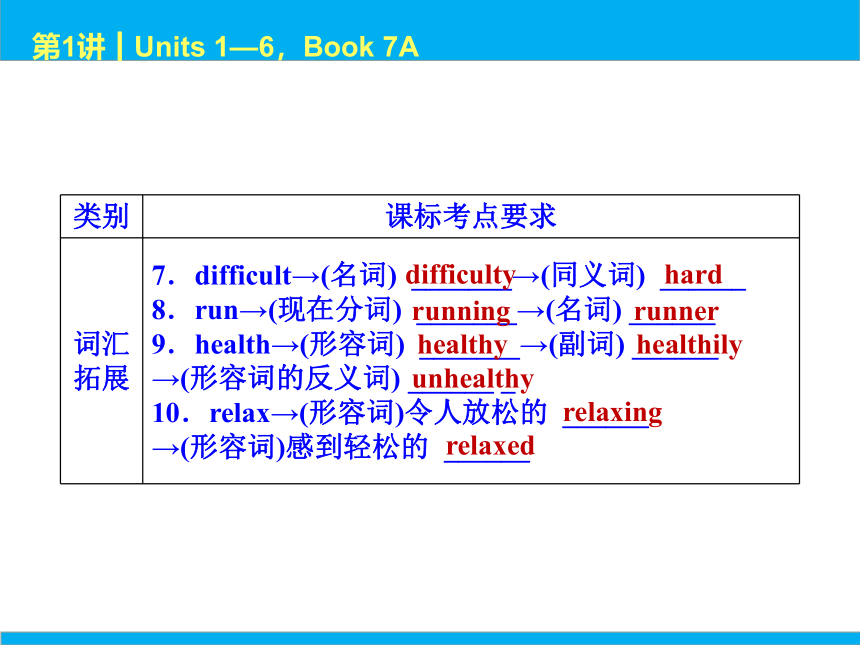
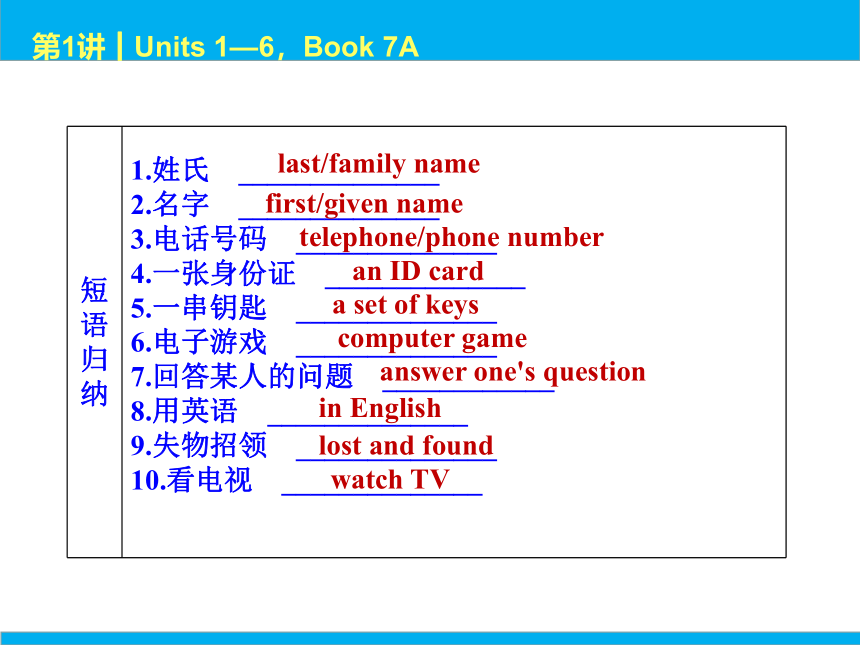

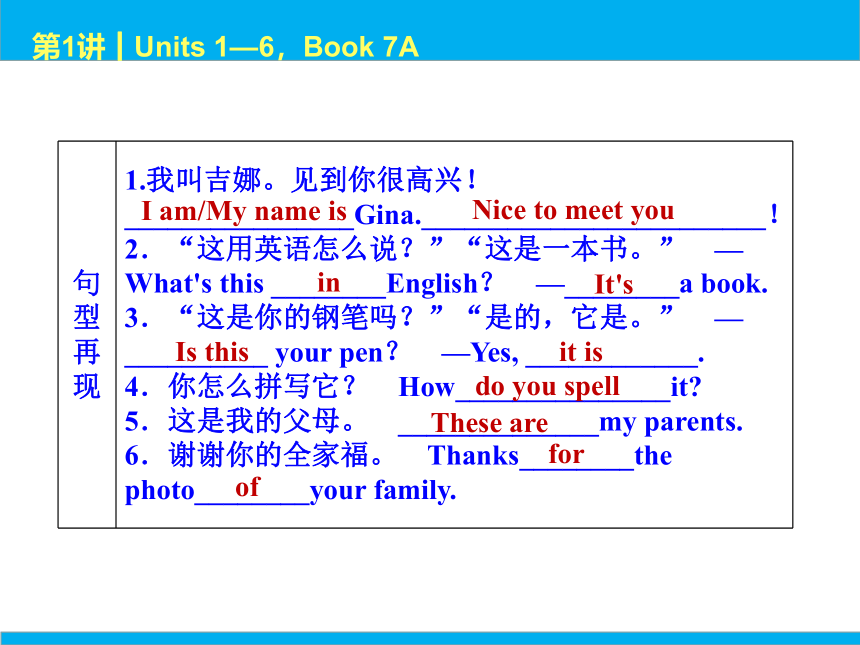
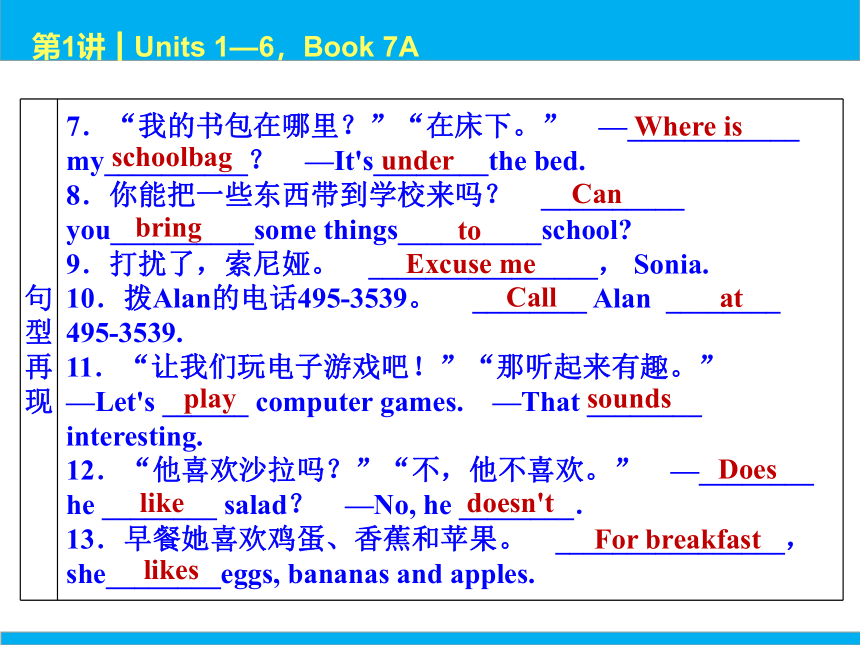
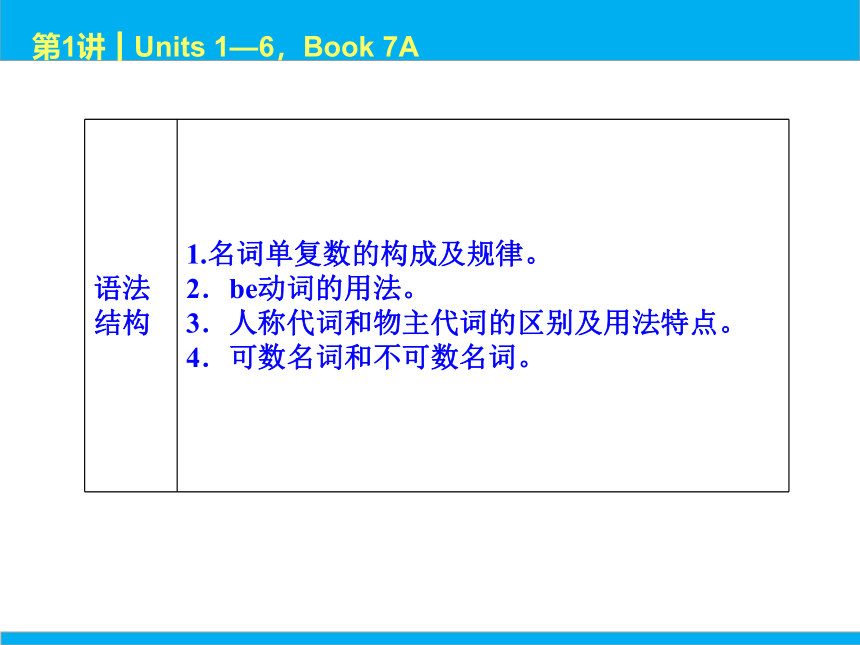
文档简介
(共25张PPT)
第1课时 Units 1—6,Book 7A
第1讲┃Units 1—6,Book 7A
自 学 反 馈
类别 课标考点要求
词汇
拓展 1.one→(序数词)__first__
2.please→(形容词) ______→(名词) ______
3.friend→(形容词) ______
→(形容词的反义词) _________→(名词)友谊 ______
4.take→(反义词) ______
5.many→(比较级) ______ →(最高级) ______
6.interest→(形容词)有趣的 __________
→(形容词)感兴趣的 _________
pleased
pleasure
friendly
unfriendly
friendship
bring
more
most
interesting
interested
第1讲┃Units 1—6,Book 7A
类别 课标考点要求
词汇
拓展 7.difficult→(名词) _______→(同义词) ______
8.run→(现在分词) _______→(名词) ______
9.health→(形容词) _______→(副词) ______
→(形容词的反义词) ______ _
10.relax→(形容词)令人放松的 ______
→(形容词)感到轻松的 ______
difficulty
hard
running
runner
healthy
healthily
unhealthy
relaxing
relaxed
第1讲┃Units 1—6,Book 7A
last/family name
短语
归纳 1.姓氏 ______________
2.名字 ______________
3.电话号码 ______________
4.一张身份证 ______________
5.一串钥匙 ______________
6.电子游戏 ______________
7.回答某人的问题 ____________
8.用英语 ______________
9.失物招领 ______________
10.看电视 ______________
first/given name
telephone/phone number
an ID card
a set of keys
computer game
answer one's question
in English
lost and found
watch TV
第1讲┃Units 1—6,Book 7A
短语
归纳
11.进行体育运动 ____________
12.铅笔盒 ______________
13.在墙上 ______________
14.在抽屉里 ______________
15.打排球 ______________
16.网球拍 ______________
17.许多 ______________
18.健康食物 ______________
19.列一个清单 _____________
play sports
pencil case
on the wall
in the drawer
play volleyball
tennis racket
lots of/a lot of
healthy food
make a list
第1讲┃Units 1—6,Book 7A
句型
再现 1.我叫吉娜。见到你很高兴! ________________Gina.________________________!
2.“这用英语怎么说?”“这是一本书。” —What's this ________English? —________a book.
3.“这是你的钢笔吗?”“是的,它是。” —__________ your pen? —Yes, ____________.
4.你怎么拼写它? How_______________it
5.这是我的父母。 ______________my parents.
6.谢谢你的全家福。 Thanks________the photo________your family.
I am/My name is
Nice to meet you
in
It's
Is this
it is
do you spell
These are
for
of
第1讲┃Units 1—6,Book 7A
句型
再现 7.“我的书包在哪里?”“在床下。” —____________ my__________? —It's________the bed.
8.你能把一些东西带到学校来吗? __________ you__________some things__________school
9.打扰了,索尼娅。 ________________, Sonia.
10.拨Alan的电话495-3539。 ________ Alan ________ 495-3539.
11.“让我们玩电子游戏吧!”“那听起来有趣。”
—Let's ______ computer games. —That ________ interesting.
12.“他喜欢沙拉吗?”“不,他不喜欢。” —________ he ________ salad? —No, he ________.
13.早餐她喜欢鸡蛋、香蕉和苹果。 ________________, she________eggs, bananas and apples.
Where is
schoolbag
under
Can
bring
to
at
Excuse me
Call
play
sounds
Does
like
doesn't
For breakfast
likes
第1讲┃Units 1—6,Book 7A
语法
结构 1.名词单复数的构成及规律。
2.be动词的用法。
3.人称代词和物主代词的区别及用法特点。
4.可数名词和不可数名词。
第1讲┃Units 1—6,Book 7A
词 汇 点 睛
1 one num.& pron. 一;一个
[点拨] one可作基数词,也可作代词,它的序数词为first,意为“第一”。表示“一次”用once。
[拓展] (1)one可用来代替上文提到的一个人或物;如果是两个或两个以上的可数的人或物则用ones代替。
I don't like red apples. Please give me green ones.
我不喜欢红苹果,请给我青苹果。
(2)one与it在指代前面所提到的名词时的区别:one指同类中不确定的一个事物;it指上文提到的同一个事物。
重 点 突 破
第1讲┃Units 1—6,Book 7A
中考典例
I've got several novels written by Mo Yan.You can
borow______if you bike. [2013·连云港]
A it B one
C every D either
B
第1讲┃Units 1—6,Book 7A
2 have v.有;吃,喝
[点拨] (1)have表示“有”,是指某人拥有;而there be表示“存在”,意为“某地有某物或某人”。
I have a new pen.我有一支新钢笔。
There is a book on the desk.桌子上有一本书。
(2)have作“吃”讲时,相当于eat;作“喝”讲时,相当于drink。
We have/eat breakfast at 7 o'clock in the morning every day. 我们每天早上7点吃早餐。
Do you want to have/drink some orange
你想喝点橙汁吗?
第1讲┃Units 1—6,Book 7A
3 family name 姓氏
[点拨] 英、美国家姓名结构:given/first name+family/last name
中国人姓名结构:family/last name+given/first name
My name is Bill Smith. Smith is my family name and Bill is my given name.我叫比尔·史密斯。史密斯是我的姓,比尔是我的名。
第1讲┃Units 1—6,Book 7A
1 look/see/watch/read
易混词 词性和意思 用法
look v. 看…… 不及物动词,后接宾语时要用
look at。
v.看上去,
看起来 作系动词,后接形容词作表语。
see v. 看见,
看到 强调看的结果。“看医生(see the
/a doctor)”、“看电影(see a film
=watch a movie)”常用这个词。
巧 辩 异 同
第1讲┃Units 1—6,Book 7A
watch v. 观看,
注视 常用来表示看活动的画面,“看电视(watch TV)”、和“看比赛(实验以及各种表演等)”习惯上用这个词。
n. 手表 其复数形式是watches。
read v. 读,看 常用于表示“读书,看报纸、杂志” 等。
第1讲┃Units 1—6,Book 7A
Look at the picture. What can you see in it
看这张画,你能看到里面有什么?
You'd better go to see a doctor.
你最好去看看医生。
Would you like to watch a football match with me
您愿意同我一起去看一场足球赛吗?
My father usually reads newspapers after supper.
我爸爸常在晚饭后读报。
第1讲┃Units 1—6,Book 7A
中考典例
I prefer _____TV to _____books.
A watching reading
B reading watching
C seeing watching
D watching looking
A
第1讲┃Units 1—6,Book 7A
2 bring/take/get/fetch/carry
bring意为“拿来;带来”,指从别处带到说话处。
take意为“拿去;带去”,指把某物(人)从说话处带到别处,与bring所表示的方向相反。
get表示到某地去把某物取来,相当于fetch。
bring意为“搬运;携带”,没有方向性。
第1讲┃Units 1—6,Book 7A
中考典例
-Sam,my iPhone is in my bedroom. Could you _______it for me
-No problem. [2013·荆州]
A bring B fetch
C take D carry
B
第1讲┃Units 1—6,Book 7A
3 every/each
易混词 词性 用法
every 形容词 指三者或三者以上范围中的“每一个”,侧重总体,不能单独使用,只作定语。
each 形容词 指两者或两者以上中的“每一个”,侧重个体,与单数可数名词连用谓语动词用单数,与复数可数名词连用谓语动词用复数,
代词 可作主语、同位语、定语或宾语,其后可跟介词of。
第1讲┃Units 1—6,Book 7A
特别注意:each 放在主语we/they/you等词后面作同位语时,谓语动词用复数。
Every student is very happy.
每个学生都很开心。
There are many trees on each side of the street.
街道两边有许多树。
Each of them has been to Paris.
他们每个人都去过巴黎。
We each have different opinions about the plan.
关于这项计划,我们各自有不同的意见。
第1讲┃Units 1—6,Book 7A
1 Call Alan at 495-3539.
拨Alan的电话495-3539。
[点拨] (1)“call sb at+电话号码”表示“拨……号码找某人”。
(2)这是一个祈使句。祈使句变否定句时在前面加Don't。
Don't call him in the morning.
不要在早晨给他打电话。
[拓展] call 还有“拜访”的意思,常用搭配:
call on sb; call at sp
句 型 透 视
第1讲┃Units 1—6,Book 7A
2 Thanks for the photo of your family.
谢谢你的全家福。
[句型] thanks for…=thank you for…, 表示 “因……表示感谢”,介词for后接名词或动词ing形式。
Thanks for helping me.
=Thank you for helping me. 谢谢你的帮助。
[拓展] thanks to意为“由于,多亏”,其中to为介词,并非不定式符号。
第1讲┃Units 1—6,Book 7A
3 Let's play soccer.我们踢足球吧。
[点拨] “Let's…”意思是“咱们……吧。”let后面的宾语如果是代词,应用宾格,后面接不带to的不定式(即动词原形)。
肯定回答:OK./Sure./Certainly./Good idea./All right.等。否定回答:Sorry, I…或No, let's…
[拓展] let sb do sth表示“让某人做某事
Let him come in.让他进来。
第1讲┃Units 1—6,Book 7A
中考典例
China plans to let tourists______ the XiSha
Islands in the South China Sea this year.
[2021·荆州]
A visit B visits C visiting D visited
A
根据 let sb do sth 结构可知选A
解析
第1课时 Units 1—6,Book 7A
第1讲┃Units 1—6,Book 7A
自 学 反 馈
类别 课标考点要求
词汇
拓展 1.one→(序数词)__first__
2.please→(形容词) ______→(名词) ______
3.friend→(形容词) ______
→(形容词的反义词) _________→(名词)友谊 ______
4.take→(反义词) ______
5.many→(比较级) ______ →(最高级) ______
6.interest→(形容词)有趣的 __________
→(形容词)感兴趣的 _________
pleased
pleasure
friendly
unfriendly
friendship
bring
more
most
interesting
interested
第1讲┃Units 1—6,Book 7A
类别 课标考点要求
词汇
拓展 7.difficult→(名词) _______→(同义词) ______
8.run→(现在分词) _______→(名词) ______
9.health→(形容词) _______→(副词) ______
→(形容词的反义词) ______ _
10.relax→(形容词)令人放松的 ______
→(形容词)感到轻松的 ______
difficulty
hard
running
runner
healthy
healthily
unhealthy
relaxing
relaxed
第1讲┃Units 1—6,Book 7A
last/family name
短语
归纳 1.姓氏 ______________
2.名字 ______________
3.电话号码 ______________
4.一张身份证 ______________
5.一串钥匙 ______________
6.电子游戏 ______________
7.回答某人的问题 ____________
8.用英语 ______________
9.失物招领 ______________
10.看电视 ______________
first/given name
telephone/phone number
an ID card
a set of keys
computer game
answer one's question
in English
lost and found
watch TV
第1讲┃Units 1—6,Book 7A
短语
归纳
11.进行体育运动 ____________
12.铅笔盒 ______________
13.在墙上 ______________
14.在抽屉里 ______________
15.打排球 ______________
16.网球拍 ______________
17.许多 ______________
18.健康食物 ______________
19.列一个清单 _____________
play sports
pencil case
on the wall
in the drawer
play volleyball
tennis racket
lots of/a lot of
healthy food
make a list
第1讲┃Units 1—6,Book 7A
句型
再现 1.我叫吉娜。见到你很高兴! ________________Gina.________________________!
2.“这用英语怎么说?”“这是一本书。” —What's this ________English? —________a book.
3.“这是你的钢笔吗?”“是的,它是。” —__________ your pen? —Yes, ____________.
4.你怎么拼写它? How_______________it
5.这是我的父母。 ______________my parents.
6.谢谢你的全家福。 Thanks________the photo________your family.
I am/My name is
Nice to meet you
in
It's
Is this
it is
do you spell
These are
for
of
第1讲┃Units 1—6,Book 7A
句型
再现 7.“我的书包在哪里?”“在床下。” —____________ my__________? —It's________the bed.
8.你能把一些东西带到学校来吗? __________ you__________some things__________school
9.打扰了,索尼娅。 ________________, Sonia.
10.拨Alan的电话495-3539。 ________ Alan ________ 495-3539.
11.“让我们玩电子游戏吧!”“那听起来有趣。”
—Let's ______ computer games. —That ________ interesting.
12.“他喜欢沙拉吗?”“不,他不喜欢。” —________ he ________ salad? —No, he ________.
13.早餐她喜欢鸡蛋、香蕉和苹果。 ________________, she________eggs, bananas and apples.
Where is
schoolbag
under
Can
bring
to
at
Excuse me
Call
play
sounds
Does
like
doesn't
For breakfast
likes
第1讲┃Units 1—6,Book 7A
语法
结构 1.名词单复数的构成及规律。
2.be动词的用法。
3.人称代词和物主代词的区别及用法特点。
4.可数名词和不可数名词。
第1讲┃Units 1—6,Book 7A
词 汇 点 睛
1 one num.& pron. 一;一个
[点拨] one可作基数词,也可作代词,它的序数词为first,意为“第一”。表示“一次”用once。
[拓展] (1)one可用来代替上文提到的一个人或物;如果是两个或两个以上的可数的人或物则用ones代替。
I don't like red apples. Please give me green ones.
我不喜欢红苹果,请给我青苹果。
(2)one与it在指代前面所提到的名词时的区别:one指同类中不确定的一个事物;it指上文提到的同一个事物。
重 点 突 破
第1讲┃Units 1—6,Book 7A
中考典例
I've got several novels written by Mo Yan.You can
borow______if you bike. [2013·连云港]
A it B one
C every D either
B
第1讲┃Units 1—6,Book 7A
2 have v.有;吃,喝
[点拨] (1)have表示“有”,是指某人拥有;而there be表示“存在”,意为“某地有某物或某人”。
I have a new pen.我有一支新钢笔。
There is a book on the desk.桌子上有一本书。
(2)have作“吃”讲时,相当于eat;作“喝”讲时,相当于drink。
We have/eat breakfast at 7 o'clock in the morning every day. 我们每天早上7点吃早餐。
Do you want to have/drink some orange
你想喝点橙汁吗?
第1讲┃Units 1—6,Book 7A
3 family name 姓氏
[点拨] 英、美国家姓名结构:given/first name+family/last name
中国人姓名结构:family/last name+given/first name
My name is Bill Smith. Smith is my family name and Bill is my given name.我叫比尔·史密斯。史密斯是我的姓,比尔是我的名。
第1讲┃Units 1—6,Book 7A
1 look/see/watch/read
易混词 词性和意思 用法
look v. 看…… 不及物动词,后接宾语时要用
look at。
v.看上去,
看起来 作系动词,后接形容词作表语。
see v. 看见,
看到 强调看的结果。“看医生(see the
/a doctor)”、“看电影(see a film
=watch a movie)”常用这个词。
巧 辩 异 同
第1讲┃Units 1—6,Book 7A
watch v. 观看,
注视 常用来表示看活动的画面,“看电视(watch TV)”、和“看比赛(实验以及各种表演等)”习惯上用这个词。
n. 手表 其复数形式是watches。
read v. 读,看 常用于表示“读书,看报纸、杂志” 等。
第1讲┃Units 1—6,Book 7A
Look at the picture. What can you see in it
看这张画,你能看到里面有什么?
You'd better go to see a doctor.
你最好去看看医生。
Would you like to watch a football match with me
您愿意同我一起去看一场足球赛吗?
My father usually reads newspapers after supper.
我爸爸常在晚饭后读报。
第1讲┃Units 1—6,Book 7A
中考典例
I prefer _____TV to _____books.
A watching reading
B reading watching
C seeing watching
D watching looking
A
第1讲┃Units 1—6,Book 7A
2 bring/take/get/fetch/carry
bring意为“拿来;带来”,指从别处带到说话处。
take意为“拿去;带去”,指把某物(人)从说话处带到别处,与bring所表示的方向相反。
get表示到某地去把某物取来,相当于fetch。
bring意为“搬运;携带”,没有方向性。
第1讲┃Units 1—6,Book 7A
中考典例
-Sam,my iPhone is in my bedroom. Could you _______it for me
-No problem. [2013·荆州]
A bring B fetch
C take D carry
B
第1讲┃Units 1—6,Book 7A
3 every/each
易混词 词性 用法
every 形容词 指三者或三者以上范围中的“每一个”,侧重总体,不能单独使用,只作定语。
each 形容词 指两者或两者以上中的“每一个”,侧重个体,与单数可数名词连用谓语动词用单数,与复数可数名词连用谓语动词用复数,
代词 可作主语、同位语、定语或宾语,其后可跟介词of。
第1讲┃Units 1—6,Book 7A
特别注意:each 放在主语we/they/you等词后面作同位语时,谓语动词用复数。
Every student is very happy.
每个学生都很开心。
There are many trees on each side of the street.
街道两边有许多树。
Each of them has been to Paris.
他们每个人都去过巴黎。
We each have different opinions about the plan.
关于这项计划,我们各自有不同的意见。
第1讲┃Units 1—6,Book 7A
1 Call Alan at 495-3539.
拨Alan的电话495-3539。
[点拨] (1)“call sb at+电话号码”表示“拨……号码找某人”。
(2)这是一个祈使句。祈使句变否定句时在前面加Don't。
Don't call him in the morning.
不要在早晨给他打电话。
[拓展] call 还有“拜访”的意思,常用搭配:
call on sb; call at sp
句 型 透 视
第1讲┃Units 1—6,Book 7A
2 Thanks for the photo of your family.
谢谢你的全家福。
[句型] thanks for…=thank you for…, 表示 “因……表示感谢”,介词for后接名词或动词ing形式。
Thanks for helping me.
=Thank you for helping me. 谢谢你的帮助。
[拓展] thanks to意为“由于,多亏”,其中to为介词,并非不定式符号。
第1讲┃Units 1—6,Book 7A
3 Let's play soccer.我们踢足球吧。
[点拨] “Let's…”意思是“咱们……吧。”let后面的宾语如果是代词,应用宾格,后面接不带to的不定式(即动词原形)。
肯定回答:OK./Sure./Certainly./Good idea./All right.等。否定回答:Sorry, I…或No, let's…
[拓展] let sb do sth表示“让某人做某事
Let him come in.让他进来。
第1讲┃Units 1—6,Book 7A
中考典例
China plans to let tourists______ the XiSha
Islands in the South China Sea this year.
[2021·荆州]
A visit B visits C visiting D visited
A
根据 let sb do sth 结构可知选A
解析
